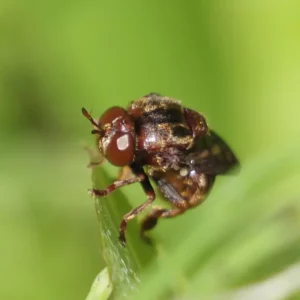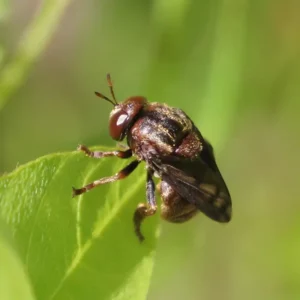Note: All links leave to external sites.
Greetings, BugFans,
When the BugLady first spotted this fly, she thought it might be one of the odd, stubby, little tachinid flies in the genus Gymnoclytia (or thereabouts). She couldn’t find anything that matched, so she asked BugFan PJ, who steered her to some odd, stubby, little flies in the Syrphid/Flower/Hover fly family (Syrphidae), in the subfamily Microdontinae, the genus Microdon and the subgenus Dimeraspis (syrphids often look more like this). PJ suspects that it’s Microdon abditus (the Broad-footed Ant Fly), or possibly Microdon globosus (the Globular Ant Fly) – the proportionate lengths of the segments of the antennae are an important field mark here, and the BugLady’s pictures just aren’t sharp enough to say for sure. Thanks, PJ.
It’s a small genus that’s found worldwide, with about 20 species in North America. Here’s Microdon abditus – it’s furry, but some species are furrier (Microdon tristis, Microdon megalogaster), and a few are metallic.
At first, the BugLady thought that this was going to be a really short episode, because nobody seems to know an awful lot about any of the species, except that they are highly variable, so identifying them to species can be challenging, and many are under-studied (which is not surprising considering where their larvae live). But she found some info about the genus, and partial biographies of some of the species, and – what a dynamite group of flies! Their taxonomy is being scrutinized, of course. Microdon has been kind of a “catch-all” genus, but once the dust has settled and the genus has been “sanitized,” the Ant flies may be elevated to family status (Microdontinae is considered an “aberrant subfamily”).

Microdon flies are myrmecophiles – ant-lovers – whose larvae grow up in ant nests (and a few in termite and wasp nests) and whose adults do not hover over flowers but may hover over their natal ant hills and are seldom far away from them. Many Microdon species are hitched to a single species of host (the only ant host recorded for the Globular Ant fly is the Odorous house ant Tapinoma sessile), so the fly’s range lies within that of their ant.
Other than a buzzing sound, which may be either defensive or a part of courtship, there is no wooing in the Microdon flies. Adults leave the nest (unless they’ve made a fatal error within, more about that in a sec) and mating occurs nearby, with the female fresh out of her pupal case. About 24 hours later, she deposits her eggs in the vicinity of an ant nest and dies soon afterwards, and when they hatch, her very-active larvae hike into the nest. An early observer wondered if some mating and ovipositing might actually take place inside the nest.
The life of Microdon larvae in an ant nest is complicated – they survive their stay partially because they keep a low profile, partially because they are somewhat armored, and partly because they produce pseudopheromones that make them smell like colony members (the adult flies don’t; the larvae pupate near the exits of the nest and when the adults emerge, they must get out of Dodge in a hurry). R. M. Duffield wrote in 1981 that “First-instars [first-stage larvae] placed in ant nests had mortality rates of 90% or more. Iridomyrmex workers easily turned over the first-instar larvae and carried them out of the colony to the refuse piles where they desiccated and dried.” The BugLady assumes that these transplants didn’t have the scent of the colony.
Bugguide.net says that “Instars 1 and 2 mimic ant cocoons. If the nest is disturbed and workers start moving cocoons to safety, the Microdon larvae curl up to look like ant cocoons, and the ants will pick them up and relocate.”
Once again, the BugLady was entranced by century-plus-old scientific writing. In a wonderful paper in the Journal of the New York Entomological Society, (Vol. XVI), 1908, William Morton Wheeler wrote of the behavior of the newly-emerged adults in the nest, “Their bodies were moist and their covering of pile [hair] was glued to the chitinous surface. While in this stage they walked about among the ants without being noticed or, at any rate, without being molested. After a few hours, or sometimes much sooner, their wings had expanded and were folded over each other on their backs, their integument had acquired the adult metallic coloration and the pile had dried and become conspicuous. They remained very quiet except when rudely touched. Then they emitted a loud humming sound, but without moving their wings. This peculiar behavior has also been noticed by Bignell (1891) in M. mutabilis. The humming attracted the ants, which at once seized the defenseless creatures by the legs or wings and drenched them with formic acid. This killed them almost instantly. These observations show very clearly that the adult M. tristis is treated with pronounced animosity even by ants among which for many months it has been tolerated with indifference as a larva and as a pupa.”
Several researchers noted that adult flies emerge from their pupil cases in the morning, when the ants are likely to be sluggish and down in the warmer regions of the nest.
Their eating habits are complex, too. Older fly larvae feed on ant larvae (one source said that they eat eggs, too) – Duffield said that “In laboratory colonies, second- and third-instar larvae consumed half-grown ant larvae or smaller ones but never pupae. Frequently the ants would pull the larvae away from the microdon. Successful microdons moved up and over the ant larvae piercing the larval skin and emptying the body contents, then discarding the empty shell. A worker would promptly pick up the larval remains and carry it to the refuse pile.”
First instar larvae, though, don’t eat ant larvae. Worker ants feed their young a masticated protein substance that the ant larvae process and feed back to the adults (a process called trophallaxis). First instar Microdon fly larvae probe the ant larvae, possibly stimulating them to regurgitate food for them. Wheeler thought that maybe worker ants accidentally drop lots of food pellets and that the fly larvae (and other non-ant-inhabitants of the nest – synoeketes) feed on this “litter.” It’s speculated that some species may be scavengers.
It is not known if the adults feed.
The BugLady admits to burying the lead here. According to Wheeler, “no tyro in entomology could fail to recognize the imagines [adults] as Syrphid flies” (um, well…).
The larvae, on the other hand, were accused for a long time of not being insects at all – in fact, because of their domed appearance and fringed edges and slow movements, studious papers in the 1800’s placed them with the slugs, or at best, with the scale insects.
Said Wheeler, “So repeatedly have even experienced observers been deceived by the singular elliptical larvae and puparia, that the history of the genus is unusually instructive. The larva of the common European species, M. mutabilis, was first seen by von Heyden, who in 1823 described and figured, but refrained from naming it. He says that he does not believe it to be ‘the larva of an insect (perhaps a species of fly) for its whole organization, especially the structure of its mouth-parts, is too different from that of any insect larva’ known to him. So he concludes that ‘it is much more probably a mollusk, but if such be the case, it must constitute a new and extraordinary genus.’
The following year (1824) von Spix found the larva of the same species of Microdon, and believing it to be a slug, named it Scntelligera amerlandia. Thereupon von Heyden published a second paper on the creature and dubbed it Parmula cocciformis, for the joy of naming things was as great in the early decades of the nineteenth century as it is to-day.
The same year Schlotthauber presented to the German naturalists assembled at Pyrmont a carefully written paper with illustrations to prove that the organisms described by von Heyden and von Spix as mollusks, were really the larvae of Microdon mutabilis. Unfortunately this paper was never published;
There is apparently no reason why unusual Microdon larvae and pupae, as fast as they are brought to light in various parts of the world, should not become the types of futile genera of naked mollusks, at least till the millennium arrives, when naturalists no longer itch to attach a name to everything that swims within their ken.
The BugLady
